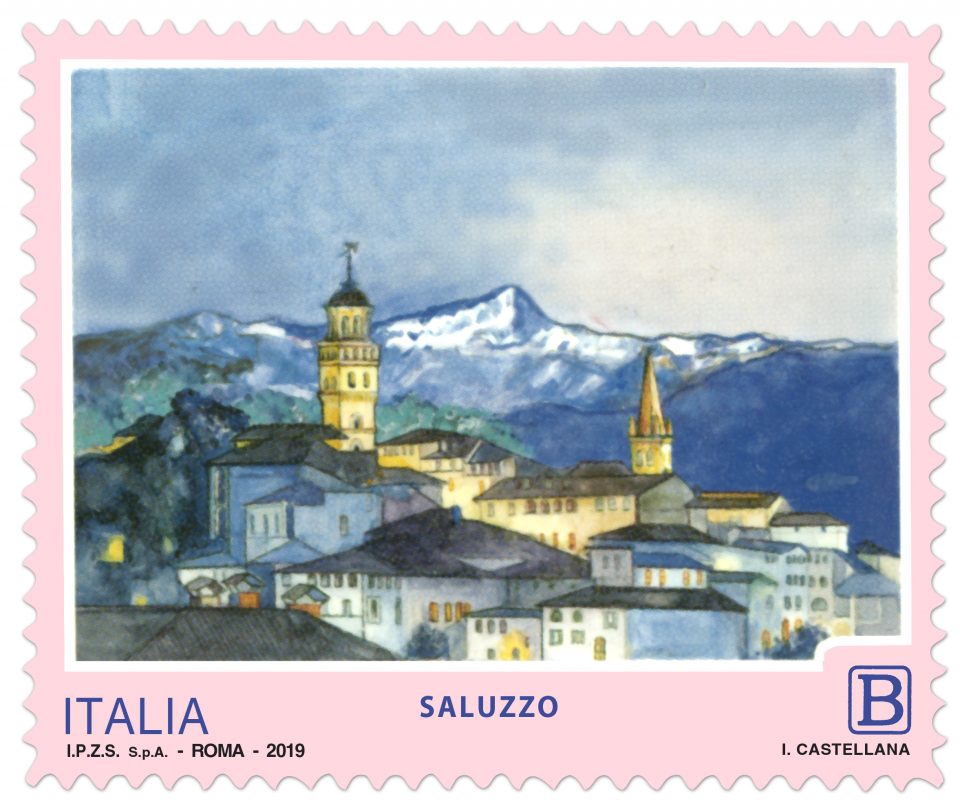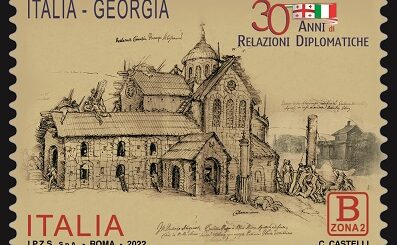POSTE ITALIANE 51^ emissione del 10 Ottobre 2019 di quattro francobolli dedicati al turismo: Troia, Portoferraio, Orbetello e Saluzzo
POSTE ITALIANE 51^ emissione del 10 Ottobre 2019 di quattro francobolli dedicati al turismo: Troia, Portoferraio, Orbetello e Saluzzo

- data / date 10 Ottobre 2019
- dentellatura / serration 11
- stampa / printing fustellatura/rotocalco
- tipo di carta / paper type bianca patinata neutra
- stampato / printed I.P.Z.S. Roma
- tiratura / edition 400.000
- fogli / sheet 28
- dimensioni / dimension 48 x 40 mm
- costo / price B = € 1,10 cadauno
- bozzettista/ designer Troia: Claudia Giusto; Portoferraio: Isabella Castellana; Orbetello: Tiziana Trinca; Saluzzo: Isabella Castellana.
- num. catalogo Troia Mi 4151 YT 3912 UN
- num. catalogo Portoferraio Mi 4152 YT 3913 UN
- num. catalogo Orbetello Mi 4153 YT 3914 UN
- num. catalogo SALUZZO Mi 4154 YT 3915 UN
Saluzzo è un comune italiano di 17.259 abitanti della Provincia di Cuneo, in Piemonte. Capitale per oltre quattro secoli, dal 1142 al 1548, del marchesato a cui diede il nome, Saluzzo è uno dei borghi medievali meglio conservati del Piemonte, situata ai piedi della catena del Monviso, allo sbocco delle valli Po e Varaita, e sede dell’omonimo parco.
Dal primo gennaio 2019 ha incorporato il comune limitrofo di Castellar.
Territorio
Saluzzo abbraccia un vasto territorio, dando l’ingresso alla Valle Po in provincia di Cuneo, la valle che porta al Monviso e alle sorgenti del fiume Po, e pertanto ospita la sede dell’Ente Parco del Po cuneese. Un po’ più a sud, Saluzzo dà anche l’ingresso alla Val Varaita. Tuttavia, essendo già in una zona semi-pianeggiante, non fa parte delle relative comunità montane. A nord invece, Saluzzo confina con Cardè e con la Riserva del torrente Bronda, Torre San Giorgio, Moretta e Scarnafigi. A est confina con Lagnasco, mentre a sud con Manta e Savigliano, a ovest con Revello, Castellar e Pagno.
Dal punto di vista storico e culturale, Saluzzo rappresenta un esempio di architettura medievale piemontese conservando, stretta nel circuito delle antiche mura, le caratteristiche di diverse epoche. Capitale per ben quattro secoli di un marchesato indipendente, le numerose testimonianze del suo nobile e ricco passato ne confermano il ruolo di città d’arte. Tutt’oggi la cittadina svolge una funzione di riferimento di servizi ai comuni circostanti, fiere e manifestazioni a carattere artistico, culturale, ortofrutticolo ed enogastromico. Oltre che ad alcuni nobili marchesi, Saluzzo ha dato il natale a molte personalità, tra le quali lo scrittore Silvio Pellico (XIX secolo) e, in tempi più recenti, il generale Carlo Alberto dalla Chiesa, ucciso dalla mafia nel 1982.
Nel 2017 il quotidiano statunitense USA Today ha inserito Saluzzo tra le undici località italiane da visitare prima che siano scoperte dalla folla.
Storia
Dell’epoca romana, risale il culto di san Chiaffredo, un soldato tebeo martirizzato in Piemonte nel III secolo, e le cui le reliquie furono traslate a Saluzzo soltanto nel XVII secolo. È poi certo che i romani vi costruirono un castrum. Durante il Medioevo, si unirono al questo anche le comunità agricole sparse, quali le Pieve di Santa Maria, San Dalmazzo di Cardè, San Lorenzo, San Martino, ecc.. Nel 1028, si attestò il territorio come parte della Marca di Torino, in proprietà al marchese Olderico Manfredi, della famiglia degli Arduinici.
Da quel momento, Saluzzo acquistò potere in quel che sarebbe diventato, alla fine dell’XI secolo, il prestigioso marchesato omonimo. Da allora, una dinastia di quattordici marchesi si succederà alla guida del piccolo Stato di confine mantenendo, anche grazie ai legami politici con la vicina Francia e con il Marchesato di Mantova, la propria autonomia politica e giungendo perfino a contendere con i Savoia il predominio dello stesso Piemonte.
Dal 1142, con Manfredo, figlio del marchese Bonifacio di Savona, diede inizio ad una dinastia marchionale che portò la piccola curtis a diventare fiorente capitale. Il Marchesato raggiunse l’apice della propria fortuna nel XV secolo, sotto i successivi governi di Ludovico I e Ludovico II quando, insieme alla prosperità economica garantita da un lungo periodo di pace, corrisponde il crescente splendore di arti e lettere. Nel 1511 ottiene da Papa Giulio II l’istituzione della Diocesi. In questi anni, Saluzzo assunse le sembianze tipicamente rinascimentali, con un borgo distribuito a ventaglio sulla collina, racchiuso da una cerchia di mura, conservate in parte fino ai giorni nostri. Al massimo della sua espansione, il controllo si estendeva su una vasta sezione dell’arco alpino occidentale, con le valli Po, Varaita, Maira, Grana e Stura, alle quali concesse ampie autonomie, come nel caso dell’Alta Val Mayra a monte di San Damiano Macra. Tra i suoi domini in pianura invece, figuravano Carmagnola, Isolabella e Valfenera, mentre sulle Langhe facevano parte del nobile marchesato i castelli e borghi di Castiglione Falletto, Lequio Berria, Dogliani con Belvedere, Roddino, Cissone e Bonvicino, quindi Marsaglia, Mombarcaro e Camerana.
Fatale fu la mancata conquista del vicino libero comune di Savigliano, alleato dei Savoia e del Marchesato del Monferrato, altrettanto importante, e che venne invece annesso al Ducato di Mantova. La sua acquisizione avrebbe potuto contenere l’espansionismo sabaudo nel Basso Piemonte. Dunque, la figura politica dei suddetti marchesi perse d’importanza, fin ad assoggettarsi a Francesco III Gonzaga. La progressiva perdita d’indipendenza, ridusse Saluzzo a periferico borgo a partire dalla seconda metà del XVI secolo. Indebolito da lotte intestine tra i discendenti di Ludovico II, nel 1548 Saluzzo fu annesso alla Francia di Enrico II di Valois, con la deposizione dell’ultimo marchese Gabriele Ludovico. Approfittando delle guerre intestine che imperversavano nella Francia del cugino Enrico III, al finire del 1588 il Duca Carlo Emanuele I di Savoia occupò militarmente il marchesato, ancora soggetto alla protezione francese. L’anno successivo, il nuovo Re di Francia (già Re di Navarra fino al 1589), Enrico IV, gli intimò la restituzione del territorio, ma Carlo Emanuele I si oppose, iniziando una guerra contro i francesi. La maggior parte delle battaglie si svolsero in Alta Val Susa e in Val Chisone, ma non durarono molto e si conclusero il 2 maggio 1598 con la cosiddetta Pace di Vervins. A mitigare le successive dispute interverrà anche Papa Clemente VIII ma, col Trattato di Lione del 1601, Carlo Emanuele I ottenne il dominio del marchesato, annettendolo ai domini di casa Savoia.
Nel 1690, dopo aver sconfitto Vittorio Amedeo II a Staffarda, Nicolas de Catinat de la Fauconnerie occupò nuovamente Saluzzo, ma fu soltanto una breve parentesi; ben presto la città e il suo territorio rientrarono nell’ambito dei domini sabaudi. Con una nuova occupazione francese nel 1798, Saluzzo divenne la sede della Sottoprefettura del Dipartimento della Stura. Poi, a seguito della caduta dell’Impero francese con la restaurazione da parte dei Savoia nel 1814, Saluzzo divenne capoluogo di provincia fino al 1859, anno in cui il titolo passò a Cuneo.
Se sei interessato all’acquisto di questo francobollo lo puoi acquistare al prezzo di €1.50. Inviami una richiesta alla email: protofilia1@gmail.com
POSTE ITALIANE 51th issue of 10 October 2019 of four stamps dedicated to tourism: Troia, Portoferraio, Orbetello and Saluzzo

- data / date 10 Ottobre 2019
- dentellatura / serration 11
- stampa / printing fustellatura/rotocalco
- tipo di carta / paper type bianca patinata neutra
- stampato / printed I.P.Z.S. Roma
- tiratura / edition 400.000
- fogli / sheet 28
- dimensioni / dimension 48 x 40 mm
- costo / price B = € 1,10 cadauno
- bozzettista/ designer Troia: Claudia Giusto; Portoferraio: Isabella Castellana; Orbetello: Tiziana Trinca; Saluzzo: Isabella Castellana.
- num. catalogo Troia Mi 4151 YT 3912 UN
- num. catalogo Portoferraio Mi 4152 YT 3913 UN
- num. catalogo Orbetello Mi 4153 YT 3914 UN
- num. catalogo SALUZZO Mi 4154 YT 3915 UN
Saluzzo is an Italian town of 17,259 inhabitants in the Province of Cuneo, in Piedmont. Capital for over four centuries, from 1142 to 1548, of the marquisate to which it gave its name, Saluzzo is one of the best preserved medieval villages of Piedmont, located at the foot of the Monviso chain, at the mouth of the Po and Varaita valleys, and home to the park of the same name. From 1 January 2019 it has incorporated the neighboring municipality of Castellar.
Territory
Saluzzo embraces a vast territory, giving the entrance to the Po Valley in the province of Cuneo, the valley that leads to Monviso and to the sources of the Po river, and therefore houses the headquarters of the Cuneo Po Park Authority. A little further south, Saluzzo also gives access to the Val Varaita. However, being already in a semi-flat area, it is not part of the relative mountain communities. To the north instead, Saluzzo borders with Cardè and with the Bronda, Torre San Giorgio, Moretta and Scarnafigi torrent reserve. To the east it borders with Lagnasco, while to the south with Manta and Savigliano, to the west with Revello, Castellar and Pagno. From a historical and cultural point of view, Saluzzo represents an example of medieval Piedmontese architecture, preserving the characteristics of different eras in the circuit of the ancient walls. Capital for four centuries of an independent marquis, the numerous testimonies of its noble and rich past confirm its role as a city of art. Even today, the town performs a function of reference to services to the surrounding municipalities, fairs and events of an artistic, cultural, fruit and vegetable and enogastronomic nature. In addition to some noble marquises, Saluzzo has given birth to many personalities, including the writer Silvio Pellico (19th century) and, more recently, General Carlo Alberto of the Church, killed by the Mafia in 1982. In 2017, the US newspaper USA Today included Saluzzo among the eleven Italian locations to visit before they are discovered by the crowd.
History
The cult of St. Chiaffredo, a Theban soldier martyred in Piedmont in the third century, dates back to Roman times and whose relics were transferred to Saluzzo only in the seventeenth century. It is then certain that the Romans built a castrum there. During the Middle Ages, scattered agricultural communities joined this, such as the Pieve di Santa Maria, San Dalmazzo di Cardè, San Lorenzo, San Martino, etc. In 1028, the territory was established as part of the Marca di Torino, in property of the Marquis Olderico Manfredi, of the Arduinici family. From that moment, Saluzzo gained power in what would have become, at the end of the 11th century, the prestigious homonymous marquisate. Since then, a dynasty of fourteen marquises will succeed the leadership of the small border state maintaining, also thanks to the political ties with neighboring France and the Marquisate of Mantua, its own political autonomy and even going so far as to contend with the Savoys the dominance of the Piedmont itself.
From 1142, with Manfredo, son of the Marquis Bonifacio of Savona, he started a marquis dynasty that led the small curtis to become a flourishing capital. The Marquisate reached the height of its fortune in the fifteenth century, under the successive governments of Ludovico I and Ludovico II when, together with the economic prosperity guaranteed by a long period of peace, corresponds the growing splendor of arts and letters. In 1511 he obtained the establishment of the Diocese from Pope Julius II. In these years, Saluzzo assumed the typically Renaissance appearance, with a village distributed like a fan on the hill, enclosed by a circle of walls, preserved in part until the present day. At the height of its expansion, control extended over a vast section of the western Alpine arc, with the Po, Varaita, Maira, Grana and Stura valleys, to which it granted ample autonomy, as in the case of the Upper Val Mayra upstream of San Damiano Macra. Among its domains on the plain instead, were Carmagnola, Isolabella and Valfenera, while in the Langhe the castles and villages of Castiglione Falletto, Lequio Berria, Dogliani with Belvedere, Roddino, Cissone and Bonvicino were part of the noble marquisate, then Marsaglia, Mombarcaro and Camerana .
Fatal was the failure to conquer the nearby free municipality of Savigliano, an ally of the Savoy and the Marquisate of Monferrato, equally important, and which was instead annexed to the Duchy of Mantua. Its acquisition could have contained the Savoy expansion in Lower Piedmont. Therefore, the political figure of the aforementioned marquises lost its importance, even to the point of submitting to Francis III Gonzaga. The progressive loss of independence reduced Saluzzo to a peripheral village starting from the second half of the sixteenth century. Weakened by infighting among the descendants of Ludovico II, in 1548 Saluzzo was annexed to the France of Henry II of Valois, with the deposition of the last marquis Gabriele Ludovico. Taking advantage of the internal wars that raged in the cousin Henry III’s France, at the end of 1588 the Duke Carlo Emanuele I of Savoy militarily occupied the marquisate, still subject to French protection. The following year, the new King of France (already King of Navarre until 1589), Henry IV, ordered him to return the territory, but Carlo Emanuele I opposed him, starting a war against the French. Most of the battles took place in Alta Val Susa and in Val Chisone, but they did not last long and ended on 2 May 1598 with the so-called Peace of Vervins. To mitigate the subsequent disputes Pope Clement VIII will also intervene, but with the Treaty of Lyon in 1601, Carlo Emanuele I obtained the dominion of the marquisate, annexing it to the domains of the House of Savoy.
In 1690, after defeating Vittorio Amedeo II in Staffarda, Nicolas de Catinat de la Fauconnerie again occupied Saluzzo, but it was only a brief period; soon the city and its territory re-entered in the domain of the Savoy dominions. With a new French occupation in 1798, Saluzzo became the headquarters of the Sub-prefecture of the Stura Department. Then, following the fall of the French Empire with the restoration by the Savoy in 1814, Saluzzo became the provincial capital until 1859, the year in which the title passed to Cuneo.
If you are interested in buying the stamp you can buy it for € 1.50. Send me a request to the email: protofilia1@gmail.com







